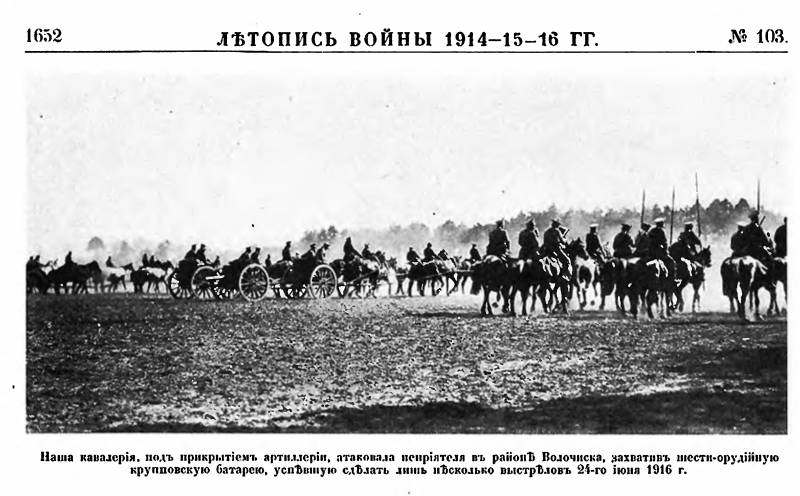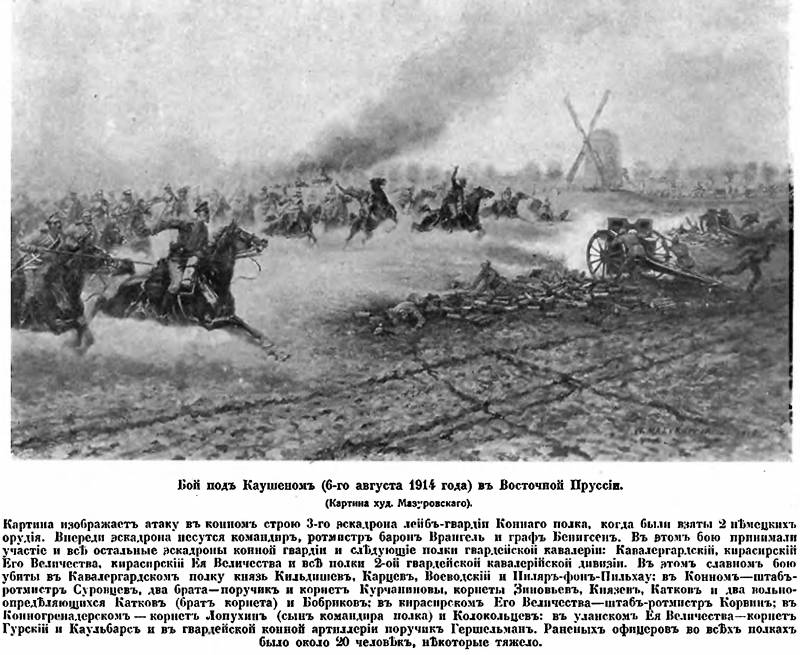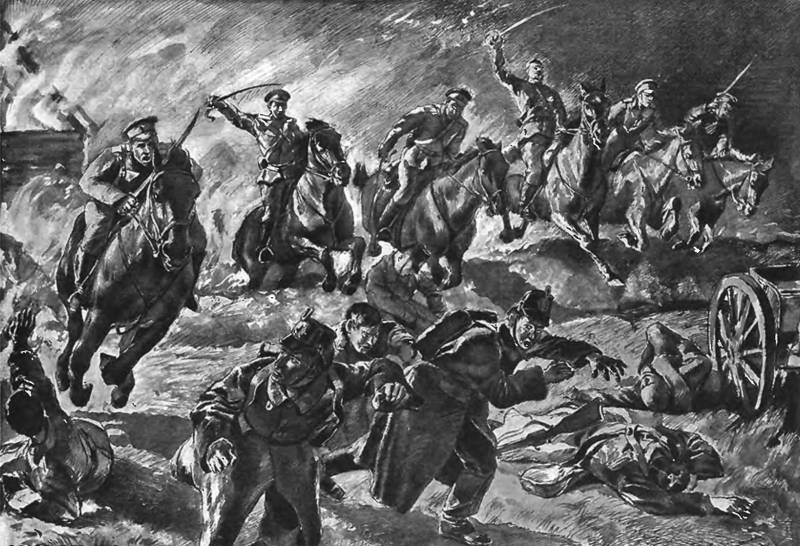Business card of the imperial cavalry. Russian cavalry attacks in the First World War
Russian horse attack
The Austro-German cavalry practiced horse attacks, but not in such quantities as the Russian ones. In the same time story The First World War on the Russian front is replete with massive equestrian attacks of the Russian cavalry, not only on cavalry, but also on infantry, machine guns, artillery and even on the fortified positions of the enemy. Many of these attacks were tactical and operational, and some were of strategic importance.
Thus, A. A. Kersnovsky highlights the defeat inflicted by the Russian cavalry of the Austro-Hungarian 7 Army on the RNS-Gorodenka 28 April 1915, the attacks on Neradov 3 July 1915, Niva Zlochevskaya 19 June 1916, etc. . (Kersnovsky A. A. History of the Russian Army. T. 4. M., 1994. C. 219.). In the course of approximately 400 equestrian attacks, 170 enemy guns were captured, a mass of prisoners were captured, and the most important combat missions were solved.
JF Rubetz briefly describes around 250 the most successful equestrian attacks that took place on the Russian front of the First World War (see Scar I.F. Equestrian attacks of the Russian Imperial cavalry in the First World War // Military news - 1964. No. 68. C. 15 - 18 .; 1965. No. 76. C. 43-47 .; 1966. No. 77. C. 8-10 .; 1966. No. 81. C. 15-19.).
We also paid attention to some of the cavalry cavalry attacks. So, we wrote about the breakthrough of the 16 Cavalry Division 23 of June 1916 in Kostyukhnovka, when several effective horseback attacks were carried out (one of the most striking is the attack of the Ulan brigade near the village of Volchetsk, which led to the capture of 14 German guns) cm. Wolf trophy), about the attacks of the 7 th hussar Belarusian regiment 2 August 1914, under Stoyanov and 3 June 1916, near der. Oschev (in the latter case, the 2 regiment of the Hungarian infantry was destroyed and 2500 prisoners were captured) (see Belarusian attack), about the attacks of the 1-th Don Cossack Division units at the 24 and 26 February 1915 Nezviska (see Nezviski. Attack of the Russian cavalry), about the attacks of the 17 th Dragoon Nizhny Novgorod Regiment under Kolushki, Blaška and Skierniewice in 1914 (see Three Nizhny Novgorod attacks. Part of 1. Through the Saxon squadron ; Three Nizhny Novgorod attacks. Part of 2. Heavy battery), about the attack of the Primorsky Dragoon Regiment under the Popelyans 1 June 1915 (see Popelyany and the strategic role of the Russian cavalry in the Baltic States), attacking parts of the 2-th Consolidated Cossack Division in Xulchus 21 July 1915 (see Chopped battalion, or Attack at Chulcice), about the attack of the brigade of the 14 Cavalry Division in Neradov 3 July 1915 (see Neradovo. History of horse attack operational value. 1 part ; Neradovo. History of horse attack operational value. 2 part), about the attacks of the Narva Hussar of 13 (Night Attack of the Narva Hussars) and 15 Ukrainian Hussars (Polish attack of Ukrainian hussars) regiments and others in articles on the Military Review. We wrote about many effective equestrian attacks that brought tangible trophies (see Oleynikov A.V. Captured in battle. Trophies of the Russian army in the First World War. M .: Veche, 2015.).
A horse attack is a very risky weapon, and only determined warlords and hardened fighters can implement it. Horse fights, as a rule, are decisive in nature, are fleeting, require high moral tension and excellent training of troops, while firefighting is less risky, but more lengthy and easier to manage. For an effective horse attack, certain tactical prerequisites were needed.
Let's look at the specifics of equestrian attacks - based on the combat episodes from the history of the Russian Front of the First World War.
It is worth noting that in the pre-war period there was a point of view that modern military equipment would not allow cavalry attacks, and if there are none, then Russian cavalry do not require strong horses like the Zadonsk horses, and that the reserve of purebred horses what Russia possessed without the Zadonsk steppe. There were voices that the peak in the 20th century is an anachronism, a dragon that only burdens the cavalryman, the main thing weapon which - a rifle with a bayonet. To a large extent, these considerations were based on the experience of the Russian-Turkish 1877-78. and Russian-Japanese 1904-1905 wars, showing the almost complete absence of equestrian attacks.
Defending the importance of cavalry in general and cavalry attacks in particular, various cavalry authors pointed to the conditions of the theater of the military during the Russian-Turkish war and the absence of any significant cavalry in Manchuria. It was also indicated that there were no leaders who believed in the significance and strength of the cavalry attack.
A fundamentally different situation occurred during the First World War. Guards cavalry attack on the German cavalry, infantry and artillery in the summer and fall of Mr. 1914, 1-attack of the Don Cossack regiment in the city of 1914, 10-part attack Cavalry Division in Jaroslavice, attacks parts 12-Cavalry Division (in particular squads 12 Hussars of the Akhtyrsky Regiment), attacks by units of the 2 Combined Cossack Division of Lieutenant-General A. A. Pavlov on the Hungarian cavalry in August 1914 in the Chertkov region, attacks by 2 squadrons of the 18 g. Nizhinsky Regiment of the Nezhinsky regiment commander Sluchevsky on German cyclists, and aka of the Ingush Equestrian Regiment of Colonel G.A. Merchule in 1916 near Yezeriany, attacks by parts of the 9 Cavalry Division and, in particular, the 9 Uhlan Bugsky Regiment of Major General V.Z. Saveliev in 1916 against Austrian infantry , the attack of the 1 th Siberian Cossack Yermak Timofeev regiment, in winter 1914 defeated the selected Turkish infantry regiment near Sarykamysh, the attacks of the 1 part of the Don Cossack division in the Balamutovka area in the spring of 1915, and many other events proved that fact 20 century cavalry cavalry attack not only possible, but also credited stuyu entails such a brilliant success for the attacking side and a defeat and frustration of the enemy troops of the enemy will not cause any artillery fire or infantry attacks or gases, or airplanes.
And below we will focus on the following combat examples, including:
1) Attack of the 4 and 5 of the hundreds of 10 of the Don Cossack Regiment against the frustrated Austrian infantry in a battle under the Oak in August 1914.
2) The attack of five hundred of the same regiment on the bivouac of the Austrian infantry regiment, which was unsuccessful and ended in a hurried battle at der. Shot in August 1914
3) An attack of five hundred of the same regiment on Austrian transports, covered by an infantry battalion, unsuccessful and ended in a combined (on foot and equestrian) formation in Khmilnik of 21 of October 1914 in.
4) Attack of 2 of hundreds of 9 Don Cossack Regiment against undisturbed Austrian infantry in November 1914 near the village of Dzvorovitsa, crowned with brilliant success.
5) The 5 th hundreds of 10 Don Cossack regiments attacked the unstructured Hungarian infantry with a force up to 600 people, produced at night, in a terrible blizzard, in the snow reaching the chest to the horses and crowned with the capture and destruction of all 6 of the enemy’s mouth, sat down. Kurini 26 February 1915
6) Attacks by hundreds of the captain of the Ingush cavalry regiment V. A. Sukhin's regiment against an unstructured Austrian infantry near the village. Yainov Polly 25 May 1915
7) 4 attacks of hundreds of 3 and 4 of Zaamur border cavalry regiments against undisturbed Austrian infantry at Dzvinyachi station of 29 in May 1915, which were a complete success.
8) The 2 attacks of hundreds of the 1 Volga Regiment against the German infantry near Posad Savin on the night of July 22 1915, due to the events that followed, stopped the German army from attacking Wlodawa for five days.
9) Attack of 3 squadrons of the 17 Uhlan Novomirgorodsky regiment in the village. Volchetsk, crowned with the capture of German guns and destruction, together with the squadron of the 17-th hussars of Chernigov, the battalion of the German infantry 24-june 1916.
10) Attacks of hundreds of 17 Don Cossack Regiment and 1 Volga Cossack Regiment in the villages of Griva, Leshnivka and Novo Chervishche of June 25 1916.
11) Attacks of 16, 17, 27 and 28 of the Don Cossack Regiments near the village of Rudka-Chervishche in August 1916
12) Attacks of the 1 of Kizlyaro-Grebensky and 1 of the Dagestan Equestrian Regiments near the villages. Neple on the German infantry in August 1916
These examples, far from being the most brilliant, are at the same time quite indicative. We deliberately take successful and unsuccessful examples of cavalry attacks in order to find out under what conditions a horse attack: a) possible, b) impossible, c) promises great success, d) despite the fact that it threatens the destruction of cavalry, still (probably worth remembering here is the most striking example - the attack on Neradov 3 July 1915 g. - see link above).
Donets at Rudka-Chervishche
The First World War showed that the fire of artillery, rifles and machine guns, airplanes are not able to stop the rushing horse attack. In the battle of 7, August 1916, at der. Rudka-Chervyshche, the attacking hundreds of 27 and 28 of the Don Cossack regiments, overcame the barrage of 2 heavy and 1 light German batteries, but then stopped at the wire.
The 27 DKP military log contains the following lines (RGVIA. F. 2007. Op. 1. D. 61. CH 1.): “7 of August: crossing the river. Stokhod under the enemy shelling and arrival in the village. Rudka-Chervyshche; the regiment's horse attack with casualties: Voloshinov’s access chair and Lazarev, the centurion, were wounded, the doctor of the Uruses wounded; Cossacks: killed 2, wounded 28, contused by 17; horses: 29 killed and 58 injured.
To be continued ...



Information